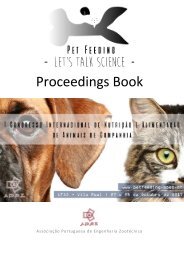Book of Proceedings I PetFeeding
You also want an ePaper? Increase the reach of your titles
YUMPU automatically turns print PDFs into web optimized ePapers that Google loves.
29<br />
The regular measurement <strong>of</strong> the BW allows to detect deviations from the expected growth rate.<br />
This can be evaluated using growth charts for kittens. As a reference, kittens grow at<br />
approximately 100 g/week until about 20 weeks <strong>of</strong> age but may grow at rates from 14 to 30<br />
g/day (Gross et al., 2010c). At 20 weeks, males typically gain 20 g/day whereas females gain<br />
11 g/day (NRC, 2006).<br />
The body condition <strong>of</strong> the kitten can also be evaluated by the 9 point body condition system<br />
developed by Laflamme (1997) for adult cats. It needs to be noted that this system is not<br />
validated for kittens, however it can be used to check if an intervention to adjust the amount <strong>of</strong><br />
food might be indicated.<br />
Nutrient Requirements<br />
The nutrient recommendations for growing kittens can be found summarized in the nutrient<br />
requirements tables <strong>of</strong> the NRC (2006). The FEDIAF guidelines (2017) also summarize nutrient<br />
recommendations for commercial diets formulated to feed growing kittens.<br />
The nutritional idiosyncrasies <strong>of</strong> cats are naturally present in kittens, and should be considered<br />
when formulating commercial as well as homemade diets for kittens (see for details <strong>of</strong><br />
idiosyncrasies in cats in Morrison, 2002).<br />
Protein<br />
Protein has a major impact on growth and development <strong>of</strong> the kitten due to its structural role in<br />
the maintenance and accretion <strong>of</strong> the lean body mass and also due to its functional role in a<br />
highly active metabolism. The ingredients selected for the kitten’s diet must be included in such<br />
a combination that is able to provide protein with high digestible and high biologic value.<br />
Arginine the protein requirements <strong>of</strong> kittens are relatively high, and diets formulated<br />
specifically for kittens have considerable concentrations <strong>of</strong> protein. Arginine, is an essential<br />
nutrient in the urea cycle, thus needs to be increased compared to adult maintenance diets. Diets<br />
with a higher protein content than recommended require more arginine.<br />
Taurine is an essential amino acid that cats cannot synthesize within their metabolism. It needs<br />
to be present in sufficient amounts in the diet for normal body function. It is needed for normal<br />
eye vision and heart function. A shortage in taurine can cause retinal degradation and a heart<br />
condition, called dilative cardiomyopathy. Taurine from dietary sources is more available to<br />
kittens than to adult cats, probably due to lower intestinal microbial degradation (Earle and<br />
Smith, 1994).<br />
Fat and Fatty acids<br />
Fat is concentrated in energy, enhances food palatability includes essential fatty acids and is<br />
needed for the intestinal abortion <strong>of</strong> fat soluble vitamins. Kittens tolerate high concentrations<br />
<strong>of</strong> fat in their diet. Energy requirements are high during the growth phase. The higher the fat



